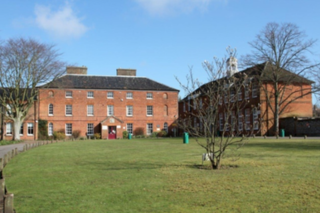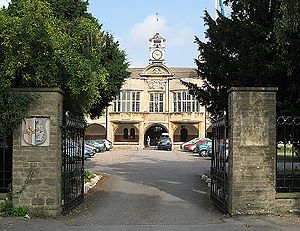
Lincoln College is a predominantly further education college based in the City of Lincoln, England.

The Liverpool Institute High School for Boys was an all-boys grammar school in the English port city of Liverpool.

Founded by King Henry VIII in 1541, The King's School is a state-funded Church of England Cathedral Chorister School located in Peterborough, England. It is the Chorister School for Peterborough Cathedral. Former pupils are known as Old Petriburgians.

Christ's College is a secondary school with academy status in East Finchley, London, United Kingdom. It falls under the London Borough of Barnet Local Education Authority for admissions. Since September 2018, Christ’s College Finchley has offered education to both girls and boys joining Year 7. The school presently has 860 pupils and specialises in Maths and Sciences.

Queen Elizabeth's Grammar School, Horncastle, is a co-educational grammar school with academy status in Horncastle, Lincolnshire, England. In 2009, there were 877 pupils, of whom 271 were in the sixth form.

Paston College is a sixth form college located in the town of North Walsham, Norfolk. The college has been part of City College Norwich, following a merger of the two colleges, since 1 December 2017.
Lincolnshire is one of the few counties within the UK that still uses the eleven-plus to decide who may attend grammar school, in common with Buckinghamshire and Kent.

Carre's Grammar School is a selective secondary school for boys in Sleaford, a market town in Lincolnshire, England.

The Lincoln College of Art was an educational institution devoted to the arts, based in the English city of Lincoln with its origins in the mid-nineteenth century. The institution changed shape and name numerous times over its history before being absorbed into the University of Lincoln. Midway through the nineteenth century, the then British Government's Department of Science and Art, based in South Kensington, began establishing a network of art schools as a means of promoting and aiding manufacturing. One of the oldest institutions of its kind in Britain, it became one of Britain's leading art schools, and was one of the first to introduce the teaching of the techniques derived from the French School of Impressionism. Many of its students went on to exhibit at the Paris Salon and the Royal Academy. Amongst its alumni are members of the Newlyn School and two Royal Academicians. It also popularised the art and crafts exhibitions in Lincolnshire that became important annual events in the late 19th and early 20th centuries.

ThePriory City of Lincoln Academy is a co-educational secondary academy and sixth form in Lincoln, Lincolnshire, England. It is a member of The Priory Federation of Academies and leads the government's School Games Organiser programme. It is also a specialist school in sports and health, exercising a partially selective intake in the former.
Matthew Humberstone Church of England School, also known as the Matthew Humberstone School, Matthew Humberstone C of E School, Matthew Humberstone Comprehensive School, MHS and Matty, was a secondary school in Cleethorpes, North East Lincolnshire, England, with a Church of England tradition. It existed between 1973 until it was closed due to amalgamation in 2010.

King Edward VI Academy is a coeducational bi-lateral secondary school and sixth form with academy status, located in Spilsby, Lincolnshire, England, for children between the ages of eleven and eighteen.

Barnes Wallis Academy is a coeducational secondary school located in the village of Tattershall in Lincolnshire, England.
The Priory Witham Academy is a mixed all-through school and sixth form located in Lincoln in the English county of Lincolnshire. The school educates pupils aged 3 to 18.

The Axholme Academy is a mixed secondary school located in Crowle, North Lincolnshire, England.

Lincoln UTC is a small University Technical College in Lincoln, England which opened in 2014 and specialises in science and engineering. The school is sponsored by the Baker Dearing Educational Trust.

William Watkins (1834–1926) was an architect who worked in Lincoln, England, and is particularly noted for his Terracotta Revival Architecture.

Henry Goddard was an English architect who was a member of a family of architects who worked in Leicester. He moved to Lincoln and was later in partnership with his son Francis Henry Goddard.

The following is a timeline of the history of the city of Lincoln, the county town of Lincolnshire in the East Midlands of England.

Lincoln Grammar School or Lincoln Free School was formed as the result of the amalgamation of the Lincoln City Free School and the Lincoln Chapter Grammar School. The amalgamation occurred in January 1584, but the two schools may have been effectively working as single school from 1560. In 1574 Lincoln City Corporation had reached an agreement with Robert Monson who was donating the Greyfriars for use as a Grammar School. This was to replace an older City Free school, which had been in scholegate. The exact location of this Free school is uncertain, but scholegate probably refers to Danesgate, but other evidence suggests that the earlier school was close to St Rumbold's church.




















